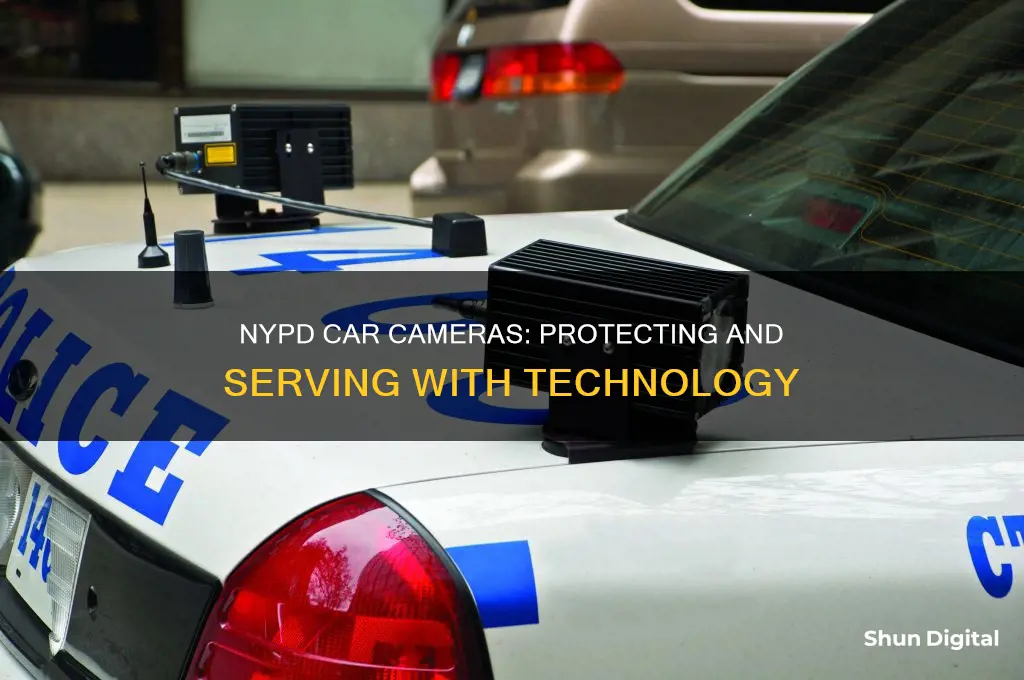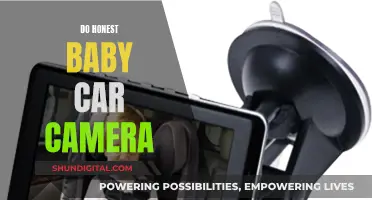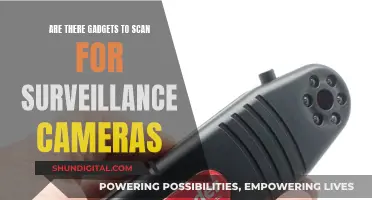
The NYPD has recently announced a redesign of its iconic patrol cars, which will now feature 360-degree camera systems. The new SUV-style vehicles will have a blue and green colour scheme, with a green stripe running down the side. Each car will be equipped with a 360-degree camera system, providing constant monitoring of the streets. The cameras will be used to record encounters between the police and the public, fostering accountability and encouraging lawful and respectful interactions. The video footage will also serve as important evidence in criminal and civil proceedings, as well as for resolving civilian complaints.
What You'll Learn
- The cameras provide an independent, objective record of encounters with the public
- They can be used as evidence in criminal and civil proceedings
- They help to de-escalate volatile encounters
- They improve officer safety during incidents
- They can be used to monitor officer activity and increase accountability

The cameras provide an independent, objective record of encounters with the public
The New York Police Department (NYPD) has been redesigning its patrol cars, which will now feature 360-degree camera systems. The cameras will provide an independent, objective record of encounters with the public.
The 360-degree camera systems will be installed in the NYPD's fleet of patrol vehicles for constant monitoring of the streets. The cameras will provide a contemporaneous and objective record of interactions between police officers and the public. This will facilitate the review of events by supervisors, foster accountability, and encourage lawful and respectful behaviour from both parties.
The cameras will also help de-escalate potentially volatile encounters and provide important evidence in criminal and civil proceedings, as well as when resolving civilian complaints. They can be used to increase accountability by monitoring officer activity and protecting both officers and the public against any impropriety.
The use of body-worn and in-car cameras by the police has been implemented with the aim of enhancing transparency and accountability in law enforcement. The cameras will capture footage of encounters with the public, providing an independent perspective that can be reviewed by supervisors and used as evidence if needed.
The NYPD's body-worn camera program is the largest in the United States, with over 24,000 members of the department equipped with body-worn cameras. The cameras are small, battery-powered digital video cameras that officers attach to their uniform shirts or winter jackets. Officers are required to manually activate the record function, and the cameras do not have enhanced recording capabilities such as night vision. The recordings are uploaded to a cloud-based storage solution at the end of each shift.
Fighting Camera Tickets: A Guide for DC Drivers
You may want to see also

They can be used as evidence in criminal and civil proceedings
The NYPD is in the process of redesigning its fleet of patrol vehicles, which will now feature 360-degree camera systems. The purpose of these cameras is to provide a contemporaneous, objective record of encounters between the police and the public. This footage can then be used as evidence in criminal and civil proceedings.
The use of body-worn and dashboard cameras has been shown to help de-escalate potentially volatile encounters between police officers and the public. The cameras also provide important evidence in criminal and civil proceedings, as well as helping to resolve civilian complaints. The footage can be used to support or refute allegations of police misconduct, protecting both the public and police officers themselves.
In the state of New York, video footage from dashboard-mounted cameras, or dashcams, can be used as evidence in legal proceedings, as long as the device is properly mounted in the car. Dashcam footage can make a significant difference in the outcome of a claim, providing proof of another driver's responsibility for a collision. It can also help to save time and money when settling a claim.
The 360-degree camera systems in NYPD vehicles will provide a similar function, offering a panoramic view of activity surrounding the police car. This will include high-definition video and high-fidelity audio, providing a comprehensive record of any encounters or incidents that occur.
The use of this technology in NYPD vehicles is intended to improve transparency, accountability, and the safety of both officers and the public. By providing an objective record of events, these camera systems can play a crucial role in criminal and civil proceedings, helping to ensure that justice is served.
Priority Tickets: Exclusive Access to Camera Audiences
You may want to see also

They help to de-escalate volatile encounters
The NYPD is redesigning its patrol cars, adding 360-degree camera systems to the iconic blue and white vehicles. The new SUVs will feature green racing stripes and a revamped interior for a more efficient and comfortable work environment for officers.
The 360-degree cameras are part of a raft of new initiatives and are expected to help de-escalate volatile encounters. The cameras will provide a contemporaneous, objective record of interactions between the police and the public. They will facilitate the review of events by supervisors, foster accountability, and encourage lawful and respectful behaviour by both the public and the police.
The cameras will also increase the safety of officers and may provide important evidence in criminal and civil proceedings, as well as helping to resolve civilian complaints.
The use of body-worn cameras by the NYPD has already shown that cameras may help de-escalate volatile encounters. The new 360-degree cameras will provide an even more comprehensive view of encounters, helping to ensure the safety of officers and the public.
The NYPD is the largest police department in the US, with 56,000 members and more than 11,000 vehicles. The new cars are expected to start hitting the streets in 2024.
Charged Camera Batteries: Marking Them Efficiently
You may want to see also

They improve officer safety during incidents
The NYPD has been working on redesigning its patrol vehicles, with plans to install 360-degree camera systems. These cameras will be used for the constant monitoring of the streets. The use of these cameras will improve officer safety during incidents in several ways.
Firstly, the cameras will provide a contemporaneous and objective record of encounters between the police and the public. This can help with reviewing incidents, fostering accountability, and encouraging lawful and respectful interactions. The presence of the cameras may also help to de-escalate potentially volatile situations, reducing the risk of harm to officers.
Secondly, the cameras can provide important evidence in criminal and civil proceedings, as well as aiding in the resolution of civilian complaints. This can help ensure that officers are not falsely accused of misconduct and can provide clarity in situations where their safety may be compromised.
Additionally, the cameras can assist in improving the efficiency and comfort of the officers' work environment. By having a constant visual record of their surroundings, officers can make more informed decisions and take appropriate action during incidents, thus improving their safety.
The 360-degree camera systems are part of the NYPD's effort to enhance public safety and respect while also providing a more modern and efficient tool for their officers. The cameras will be a valuable addition to the NYPD's iconic patrol vehicles, offering increased protection for officers during their daily duties.
Campark Cameras: Where Are They Manufactured?
You may want to see also

They can be used to monitor officer activity and increase accountability
The NYPD is in the process of redesigning its fleet of patrol vehicles, which will now include 360-degree camera systems for constant monitoring of the streets. These cameras will be used to monitor officer activity and increase accountability.
The 360-degree camera systems will provide a panoramic view, offering a broad view of the activity surrounding the police vehicle. This will allow for the preservation of an independent, objective record of what the officer encounters. The recordings will be used as evidence in court and can also be used to increase accountability by monitoring officer activity.
The cameras will also help to protect officers against frivolous complaints and protect the public against any officer impropriety. The footage can be reviewed by supervisors and used to foster accountability and encourage lawful and respectful interactions between the police and the public.
In addition to the 360-degree camera systems in police vehicles, the NYPD has also implemented a body-worn camera program, which is the largest in the United States with over 24,000 members of the department equipped with body-worn cameras. These body-worn cameras further enhance the ability to monitor officer activity and increase accountability.
Top-Down Cameras: Cara's Secret Superpower
You may want to see also
Frequently asked questions
The cameras on NYPD cars are for constant monitoring of the streets. They provide a contemporaneous, objective record of encounters between the police and the public, facilitate review of events by supervisors, foster accountability, and encourage lawful and respectful interactions.
The 360-degree camera systems on NYPD cars provide a panoramic view, offering a broad view of the activity surrounding the vehicle. This helps to ensure the safety of officers and enhance accountability by providing an independent record of their encounters.
Each NYPD car is outfitted with a 360-degree camera system, which includes multiple cameras that work together to provide a comprehensive view of the vehicle's surroundings.
The NYPD started implementing 360-degree camera systems on their vehicles in 2023 as part of a redesign of their iconic patrol cars.
Yes, privacy concerns are considered when implementing the use of cameras on NYPD cars. Officers are not required to record all interactions with the public and must follow certain guidelines regarding sensitive encounters and notifications to the public about recording.







